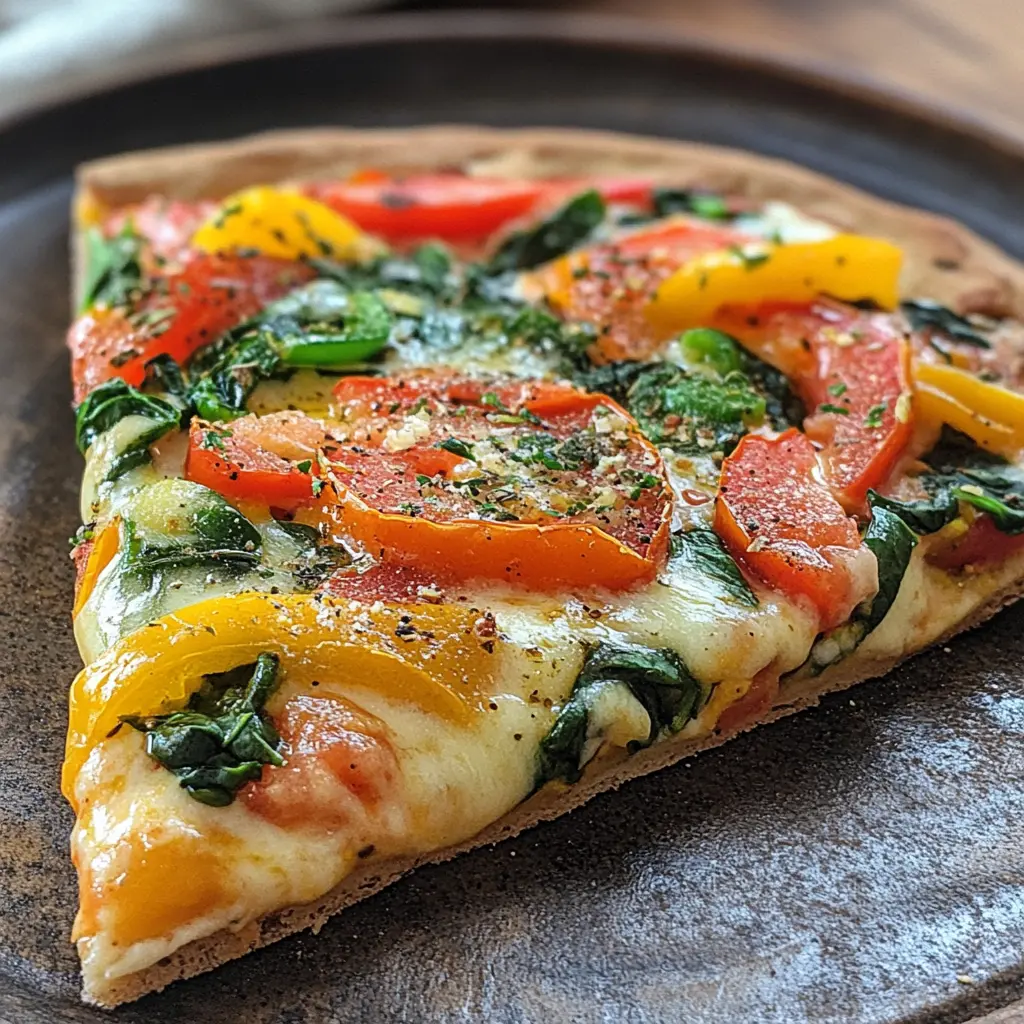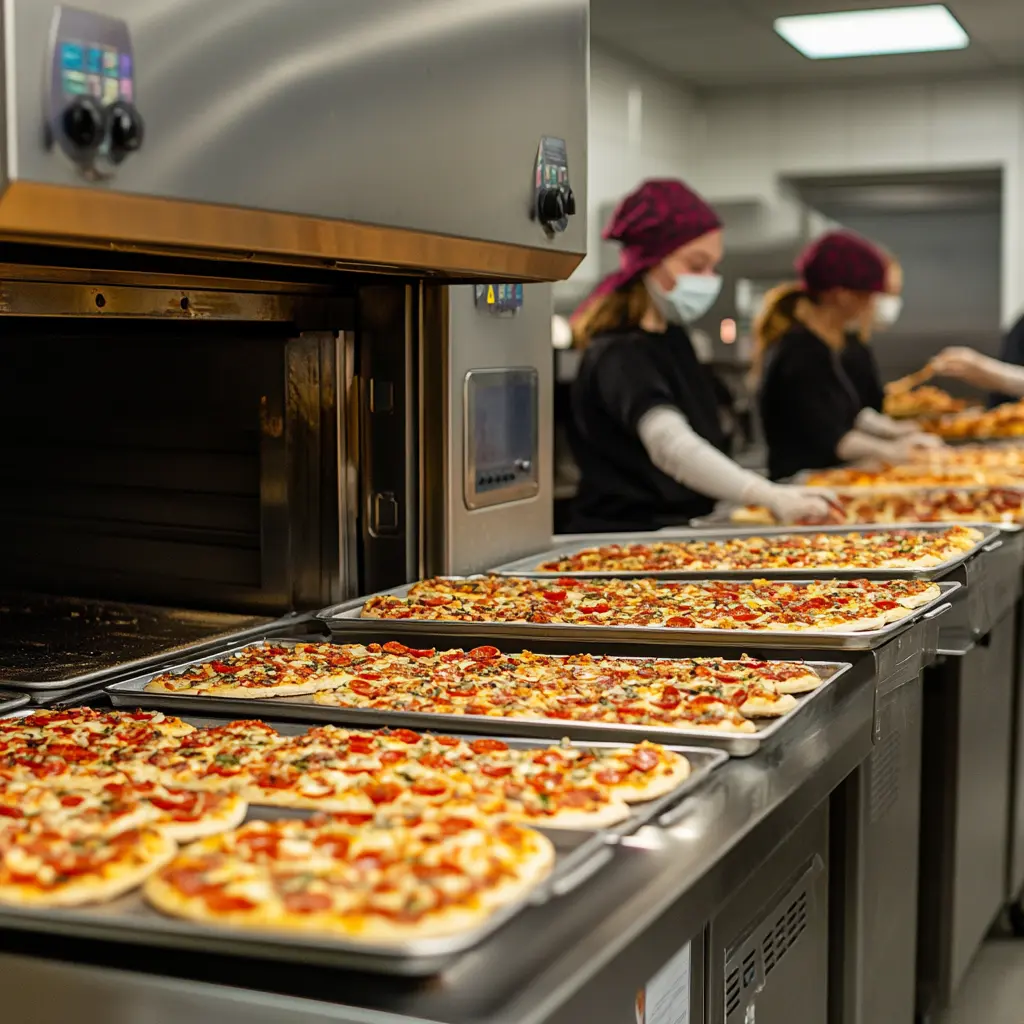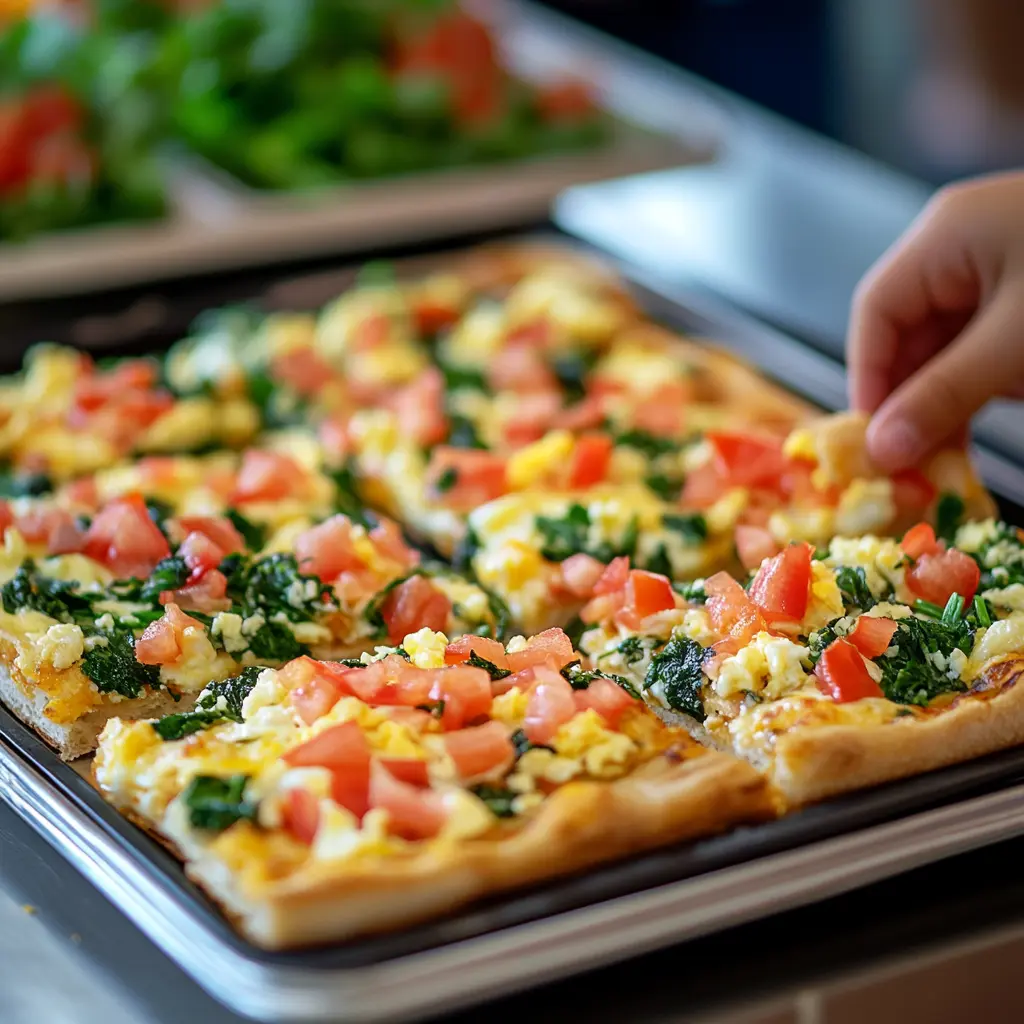Breakfast is often called the most important meal of the day, especially for children whose minds and bodies are growing rapidly. Yet, school cafeterias frequently face the challenge of offering breakfasts that are not only nutritious but also appealing to students. Enter the concept of breakfast pizza for schools—a delicious, adaptable, and health-conscious alternative to traditional breakfast options.
This innovative approach combines familiar flavors with essential nutrients, providing students with a well-rounded meal that fuels them for their academic activities. Whether crafted with protein-rich eggs, whole grain crusts, or topped with vibrant vegetables, breakfast pizzas offer endless possibilities for customization to cater to various dietary needs and preferences.
This article explores the rise of breakfast pizza in schools, its nutritional benefits, creative recipes, and practical tips for implementation in school meal programs. By the end, you’ll understand why breakfast pizza is more than a trend—it’s a revolution in school nutrition.
The Rise of Breakfast Pizza in Schools
School meal programs have evolved significantly over the years, adapting to changing nutritional standards, dietary preferences, and student tastes. Breakfast pizza, a relatively new addition to many school cafeterias, is gaining popularity as a versatile and appealing option.
Why Breakfast Options in Schools Matter
The importance of breakfast for students cannot be overstated. Studies consistently show that eating a nutritious breakfast is linked to improved academic performance, better behavior, and enhanced focus in the classroom. Despite this, many children skip breakfast due to time constraints, lack of appetite in the morning, or unappealing options available at home or school.
Breakfast pizza addresses these challenges by offering a portable, easy-to-eat meal that feels like a treat but is packed with essential nutrients. This innovation in school breakfast programs has been instrumental in increasing participation rates, ensuring more students start their day with a full stomach.
The Concept of Pizza for Breakfast for schools: A Game-Changer in Nutrition and Taste
Pizza is universally loved by children and adults alike, making it an excellent vehicle for introducing healthier breakfast options in schools. Traditionally associated with indulgence, breakfast pizza challenges this perception by incorporating balanced ingredients that align with dietary guidelines.

The appeal of breakfast pizza lies in its ability to be both familiar and exciting. Students are often drawn to the idea of having pizza in the morning, which helps combat the monotony of typical school breakfast menus. Furthermore, schools can experiment with toppings and crusts, making breakfast pizza suitable for a wide range of cultural and dietary preferences.
Early Success Stories of Breakfast Pizza Programs
Some pioneering schools have already adopted breakfast pizza into their meal plans, and the results have been overwhelmingly positive. Schools report that breakfast pizza increases meal program participation rates and encourages students who typically skip breakfast to give it a try. Teachers have also noted improved energy levels and engagement among students who start their day with this balanced meal.
For instance, a school district in the Midwest introduced breakfast pizza as part of a pilot program and saw a 20% increase in breakfast participation within the first month. This success has inspired other schools to consider adding breakfast pizza to their menus.
Aligning Breakfast Pizza with Government Standards
One of the factors contributing to the rise of breakfast pizza is its compatibility with school nutrition standards. By using whole-grain crusts, low-fat cheese, and a variety of healthy toppings, schools can meet the USDA’s guidelines for breakfast programs. Additionally, the customizable nature of breakfast pizza makes it easier to incorporate the fruits, vegetables, and proteins required in a balanced meal.
This flexibility also allows schools to meet local and state regulations while providing students with a meal they enjoy, helping bridge the gap between compliance and satisfaction.
Meeting Dietary Guidelines for Students
School meal programs are required to adhere to strict dietary guidelines to ensure that students receive the nutrients they need to thrive. Breakfast pizza can easily align with these requirements by incorporating the following components:
- Whole-Grain Crusts: Whole grains are a key component of any balanced diet, providing sustained energy and essential fiber. Using whole-grain crusts ensures that breakfast pizza contributes to daily fiber intake, improving digestion and satiety.
- Protein-Rich Toppings: Toppings such as scrambled eggs, lean meats (like turkey sausage or chicken), and low-fat cheese provide high-quality protein. Protein is essential for muscle growth and repair, as well as maintaining focus and energy throughout the morning.
- Vegetable Additions: Adding vegetables like spinach, tomatoes, bell peppers, or mushrooms boosts the pizza’s vitamin and mineral content. These nutrients are vital for cognitive development, immune support, and overall health.
By incorporating these elements, breakfast pizza delivers a well-rounded meal that fuels students for both academic and physical activities.
Customizing Toppings for Balanced Nutrition
The true beauty of breakfast pizza lies in its adaptability. Schools can tailor recipes to include ingredients that enhance nutrition while appealing to student preferences. For example:
- High-Fiber Options: Incorporate toppings like avocados or beans for added fiber and healthy fats.
- Calcium-Rich Choices: Use mozzarella or ricotta cheese to boost calcium levels for strong bones and teeth.
- Antioxidant-Rich Vegetables: Top pizzas with colorful vegetables such as red peppers, broccoli, and carrots to provide a variety of antioxidants.
These small changes can significantly increase the nutritional value of breakfast pizza without compromising taste.
Examples of Nutritious Breakfast Pizza Options
Here are three variations of breakfast pizza designed to maximize nutrition:
- Classic Egg and Veggie Pizza:
- Crust: Whole-grain
- Toppings: Scrambled eggs, cherry tomatoes, spinach, and shredded mozzarella
- Benefits: High in protein, calcium, and vitamins A and C
- Greek-Inspired Breakfast Pizza:
- Crust: Flatbread or whole-wheat pita
- Toppings: Crumbled feta, black olives, diced cucumbers, and eggs
- Benefits: Rich in healthy fats, protein, and antioxidants
- Vegan Breakfast Pizza:
- Crust: Gluten-free or whole-grain
- Toppings: Hummus base, roasted vegetables, and nutritional yeast
- Benefits: Plant-based protein, high fiber, and dairy-free
These recipes cater to a variety of dietary needs and preferences, ensuring inclusivity in school meal programs.
Addressing Common Nutritional Concerns
Some parents and educators may initially be skeptical about pizza as a breakfast option, but the nutritional profile of breakfast pizza can be adjusted to meet any concerns. For instance:
- Reducing Sodium: Use low-sodium cheeses and meats.
- Cutting Calories: Focus on vegetable-based toppings and smaller portion sizes.
- Boosting Fiber: Choose whole-grain crusts and fiber-rich ingredients like legumes and greens.
Through careful ingredient selection, breakfast pizza can provide a balanced, nutrient-dense meal that satisfies both taste and health requirements.
Creative Toppings for Breakfast Pizza for schools

One of the greatest strengths of breakfast pizza is its versatility. The toppings can be customized to appeal to diverse tastes, meet dietary restrictions, and maximize nutritional benefits. Schools can use creative combinations to make breakfast pizzas exciting and inclusive for students.
Protein-Packed Ingredients
Protein is essential for muscle development, energy, and focus, making it a key component of breakfast pizza. Here are some high-protein options:
- Eggs: Scrambled or fried eggs act as a perfect base, delivering a rich source of protein and choline, which supports brain health.
- Lean Meats: Turkey sausage, chicken breast, and Canadian bacon are flavorful, lower-fat options that add variety and substance.
- Cheese: Low-fat mozzarella, cheddar, or even ricotta contributes protein and calcium while adding creaminess to the pizza.
- Beans or Lentils: A vegetarian-friendly alternative, these legumes are packed with protein and fiber.
By incorporating these ingredients, schools can create pizzas that provide students with the energy they need for a productive morning.
Vegetarian-Friendly Alternatives
Catering to vegetarian students is increasingly important in today’s school meal programs. Vegetarian breakfast pizzas can be just as satisfying with these creative options:
- Vegetable Medley: Combine spinach, mushrooms, bell peppers, and onions for a vibrant, nutrient-rich topping.
- Plant-Based Proteins: Use tofu crumbles or plant-based sausage for a protein boost.
- Cheese Combinations: Experiment with different types of cheese, such as feta or gouda, to add unique flavors.
Vegetarian breakfast pizzas not only appeal to plant-based eaters but also introduce all students to delicious, vegetable-forward meals.
Allergen-Free and Vegan Options
Schools must also accommodate students with food allergies or dietary restrictions. With the right ingredients, breakfast pizza can be made allergen-free and vegan:
- Dairy-Free Cheeses: Use plant-based cheeses made from almond, cashew, or coconut milk.
- Gluten-Free Crusts: Substitute traditional crusts with options made from cauliflower, rice flour, or chickpea flour.
- Egg Replacements: Use scrambled tofu, chickpea flour batter, or aquafaba as an alternative to eggs.
- Nut-Free Options: Avoid nuts in toppings and sauces, and ensure all ingredients are free from cross-contamination.
These adaptations make breakfast pizza accessible to every student, regardless of dietary restrictions.
Flavorful International Inspirations
Introducing global flavors to breakfast pizzas is a fun way to expose students to different cuisines while keeping meals exciting:
- Mediterranean Delight: Topped with hummus, kalamata olives, roasted red peppers, and a sprinkle of za’atar.
- Tex-Mex Style: Features refried beans, scrambled eggs, jalapeños, and salsa.
- Asian Fusion: Includes a miso-glazed base, shiitake mushrooms, scallions, and sesame seeds.
These unique options can broaden students’ palates while providing balanced, nutritious meals.
Seasonal and Local Ingredients
Using fresh, seasonal, and locally sourced ingredients not only enhances flavor but also supports sustainability. Schools can work with local farmers to include toppings like heirloom tomatoes, fresh basil, or seasonal squash. This approach adds variety to menus while promoting environmental responsibility.
Presentation Matters
Finally, the visual appeal of breakfast pizza should not be overlooked. Vibrant colors from vegetables, creative topping arrangements, and fun shapes (like mini-pizzas or pizza slices) can make the meal more enticing for students. A pizza that looks as good as it tastes encourages children to try new ingredients and finish their meals.
Implementation in School Cafeterias
Introducing breakfast pizza into school meal programs requires careful planning and execution. From cost management to staff training, cafeterias must adopt efficient strategies to ensure smooth preparation and service.

Cost-Effective Preparation and Serving Strategies
Budget constraints are a common concern for school cafeterias. However, with smart planning, breakfast pizza can be a financially viable option:
- Bulk Purchasing: Buying ingredients like whole-grain crusts, cheese, and toppings in bulk reduces overall costs.
- Simplified Recipes: Create a base recipe for breakfast pizza that uses affordable and widely available ingredients, such as eggs, cheese, and seasonal vegetables.
- Standardized Portions: Using uniform portion sizes minimizes waste and ensures consistent nutrition across servings.
Schools can also partner with food suppliers who offer discounts for meal programs, further lowering expenses.
Bulk Production for Large-Scale Meal Services
Preparing breakfast pizza for hundreds or thousands of students requires efficiency and scalability:
- Pre-Prepped Ingredients: Use pre-shredded cheese, pre-diced vegetables, and pre-cooked crusts to save time in the kitchen.
- Batch Cooking: Utilize large baking trays or pizza ovens to prepare multiple pizzas at once, ensuring quick turnaround times.
- Frozen Options: Prepare and freeze pizzas in advance for reheating during busy mornings, maintaining quality and freshness.
These strategies make it easier for cafeterias to manage high demand without compromising on taste or quality.
Training Cafeteria Staff for Preparation
Ensuring staff are well-trained in preparing and serving breakfast pizza is crucial for consistency and efficiency:
- Workshops: Host training sessions to teach staff proper techniques for dough handling, topping distribution, and portion control.
- Standardized Recipes: Provide detailed instructions for every recipe to ensure consistency across batches.
- Time Management: Train staff on time-saving practices, such as prepping toppings the night before or optimizing oven usage.
With proper training, cafeteria staff can confidently deliver delicious breakfast pizzas that meet nutritional and quality standards.
Adapting to Kitchen Infrastructure
Not all school kitchens are equipped for pizza production, but there are solutions to overcome these limitations:
- Pizza Ovens: Investing in a commercial pizza oven can streamline the cooking process and improve efficiency.
- Multipurpose Equipment: Use existing ovens, grills, or convection ovens to bake pizzas with slight modifications to the recipes.
- Vendor Partnerships: Collaborate with local pizzerias to provide pre-made breakfast pizzas if in-house preparation is not feasible.
By adapting to existing resources, schools can introduce breakfast pizza without significant upfront costs.
Ensuring Food Safety and Hygiene
Maintaining high food safety standards is critical in school meal programs:
- Storage: Store ingredients like cheese and meats at the correct temperatures to prevent spoilage.
- Preparation Areas: Designate separate areas for handling raw and cooked ingredients to avoid cross-contamination.
- Regular Inspections: Conduct routine checks of kitchen equipment and storage facilities to ensure compliance with health regulations.
These measures protect students’ health while upholding the reputation of the meal program.
Piloting Breakfast Pizza in Schools
To gauge student interest and refine logistics, schools can start with a pilot program:
- Test Days: Serve breakfast pizza on specific days and collect feedback from students and staff.
- Survey Preferences: Use surveys to learn which toppings and flavors are most popular among students.
- Adjust and Expand: Based on feedback, make necessary adjustments before incorporating breakfast pizza into the regular menu.
A pilot program allows schools to fine-tune their approach and ensure a successful rollout.
Popular Breakfast Pizza Recipes for Schools

Breakfast pizza is as versatile as it is delicious. Schools can experiment with different recipes to cater to diverse student tastes while ensuring nutritional value. Below are some popular recipes tailored for school meal programs.
Classic Breakfast Pizza Recipe
The classic breakfast pizza is a crowd-pleaser that combines familiar breakfast ingredients with the universally loved pizza format.
- Ingredients:
- Whole-grain pizza crust
- Scrambled eggs
- Low-fat mozzarella cheese
- Diced ham or turkey sausage
- Bell peppers and onions (optional for added veggies)
- Preparation:
- Pre-bake the whole-grain crust for 5 minutes to ensure a crispy base.
- Spread a thin layer of egg mixture evenly over the crust.
- Sprinkle toppings (cheese, meat, and vegetables) generously.
- Bake in the oven at 375°F (190°C) for 10-12 minutes until the cheese is melted and golden.
- Nutrition: This pizza offers a balance of protein, fiber, and essential vitamins, making it an ideal morning meal.
Gluten-Free Breakfast Pizza
To cater to students with gluten sensitivities, this recipe uses a gluten-free crust without sacrificing taste or texture.
- Ingredients:
- Gluten-free pizza crust (available pre-made or homemade)
- Dairy-free cheese for additional allergen support
- Scrambled eggs or a vegan egg substitute
- Spinach, cherry tomatoes, and mushrooms
- Preparation:
- Assemble the toppings on the gluten-free crust.
- Bake at 375°F (190°C) for 8-10 minutes.
- Garnish with fresh herbs like parsley or basil for extra flavor.
- Nutrition: High in fiber and rich in vitamins, this pizza is an inclusive option that ensures no student is left out.
Low-Calorie Breakfast Pizza For Schools
For schools aiming to meet specific calorie guidelines, this recipe keeps things light without compromising on flavor.
- Ingredients:
- Thin whole-wheat crust or flatbread
- Egg whites
- Low-fat ricotta or cottage cheese
- Fresh vegetables like zucchini, peppers, and onions
- Preparation:
- Whisk egg whites and cook lightly in a skillet.
- Spread ricotta or cottage cheese as the base sauce on the crust.
- Top with cooked egg whites and a medley of vegetables.
- Bake for 8-10 minutes at 375°F (190°C).
- Nutrition: This pizza is low in calories yet rich in protein and essential nutrients, making it a guilt-free breakfast option.
Global-Inspired Breakfast Pizza Flavors
For schools looking to introduce students to international cuisines, these recipes provide a delicious twist:
- Italian Breakfast Pizza: Topped with pesto, prosciutto, and arugula.
- Mexican Breakfast Pizza: Includes a base of refried beans, scrambled eggs, salsa, and jalapeños.
- Middle Eastern Breakfast Pizza: Features hummus, diced cucumbers, and a drizzle of tahini.
These global-inspired options add variety to the menu and can spark cultural curiosity among students.
Mini Breakfast Pizzas for Younger Students
For younger children with smaller appetites, mini breakfast pizzas offer a fun and manageable portion size:
- Ingredients: Use whole-grain English muffins or small pita bread as the base.
- Preparation: Top each mini crust with eggs, cheese, and toppings, then bake for 5-7 minutes.
These mini pizzas are perfect for younger students and are easy for cafeteria staff to prepare in large quantities.
Seasonal Specialties
Introducing seasonal breakfast pizza options keeps the menu fresh and exciting:
- Spring Veggie Pizza: Asparagus, peas, and fresh herbs.
- Summer Harvest Pizza: Zucchini, cherry tomatoes, and corn.
- Autumn Flavors Pizza: Butternut squash, caramelized onions, and sage.
- Winter Comfort Pizza: Sweet potatoes, kale, and cranberries.
These options showcase the variety of fresh produce available throughout the year and align with sustainability efforts.
FAQs About Breakfast Pizza for Schools
What brand were school pizzas?
The school pizzas that many remember from years past were often provided by companies specializing in institutional food services, such as Tony’s Pizza or Schwan’s Food Service. These brands became staples in school cafeterias due to their affordability, ease of preparation, and ability to meet nutrition standards. Today, many schools source pizzas from brands that offer whole-grain crusts and reduced-fat ingredients to comply with updated dietary guidelines.
Does Domino’s make breakfast pizza?
Yes, Domino’s has experimented with breakfast pizza in select markets, although it is not a standard menu item at most locations. For schools, Domino’s offers Smart Slice, a program that provides pizzas tailored to meet USDA school lunch guidelines. While not specifically breakfast-oriented, these pizzas can be adapted with breakfast toppings if schools partner with Domino’s for their meal programs.
How do you pack pizza for school lunch?
Packing pizza for school lunches requires thoughtful preparation to maintain freshness and flavor:
- Cooling: Let the pizza cool completely before packing to avoid sogginess.
- Storage: Use an insulated lunchbox to keep the pizza warm or a refrigerated container for cold storage.
- Wrappings: Wrap slices in parchment paper or use a reusable container to preserve freshness.
- Extras: Include a small sauce container or a side of fresh fruit to balance the meal.
For breakfast pizzas, the same principles apply. Many schools serve them hot in cafeterias, but packed versions work well for on-the-go meals.
What does breakfast pizza contain?
Breakfast pizza typically includes a base of:
- Crust: Whole-grain or gluten-free options are common.
- Sauce: Alternatives like scrambled eggs, cream cheese, or marinara.
- Toppings: Eggs, cheese, lean meats (ham, sausage), and vegetables like bell peppers or spinach.
Customization options include plant-based proteins, dairy-free cheeses, and international flavors, making breakfast pizza a versatile and nutritious meal.
What was school cafeteria food from the 80s?
School cafeteria food in the 1980s often consisted of simpler, less nutrition-regulated options compared to today. Popular items included:
- Square-shaped pizza slices with a soft, doughy crust.
- Tater tots and French fries as standard sides.
- Sweet treats like pudding cups and fruit cocktail.
While nostalgic for many, these meals were typically higher in fat and sodium. Modern school menus, including breakfast pizzas, focus on providing balanced, nutrient-rich meals.
How much does Smart Mouth pizza cost?
The cost of Smart Mouth Pizza varies by school district, as it depends on portion sizes, topping selections, and the partnership agreements with the supplier. On average, Smart Mouth pizza costs schools between $2.50 and $4.00 per serving, which is aligned with other school meal options under the USDA’s National School Lunch Program.
Is school lunch pizza healthy?
Modern school lunch pizza, including breakfast pizza, is much healthier than its traditional counterpart. Schools now prioritize:
- Whole-Grain Crusts: To increase fiber intake.
- Low-Fat Cheeses: To reduce saturated fat content.
- Lean Proteins and Vegetables: For a balanced, nutrient-dense meal.
By adhering to USDA guidelines, school lunch pizzas provide essential nutrients while keeping calories, sodium, and fat levels in check.
Does Tombstone pizza still exist?
Yes, Tombstone Pizza still exists and remains a popular frozen pizza brand. It is widely available in grocery stores across the United States. While Tombstone pizzas are not typically associated with school cafeterias, they are a nostalgic favorite for many families and can inspire similar flavors for breakfast pizzas in schools.
For those looking to make the most out of simple and accessible ingredients, banana bread is a timeless classic. If you have just two ripe bananas on hand, you can create a moist and flavorful loaf. Check out this Banana Bread Recipe with Two Bananas: A Complete Guide to discover a straightforward and delicious way to bake your own. Alternatively, for a broader range of techniques and variations, Simply Recipes Banana Bread provides step-by-step instructions and creative tips for perfecting this household favorite. Whether you’re a seasoned baker or trying banana bread for the first time, these resources will guide you to success.

